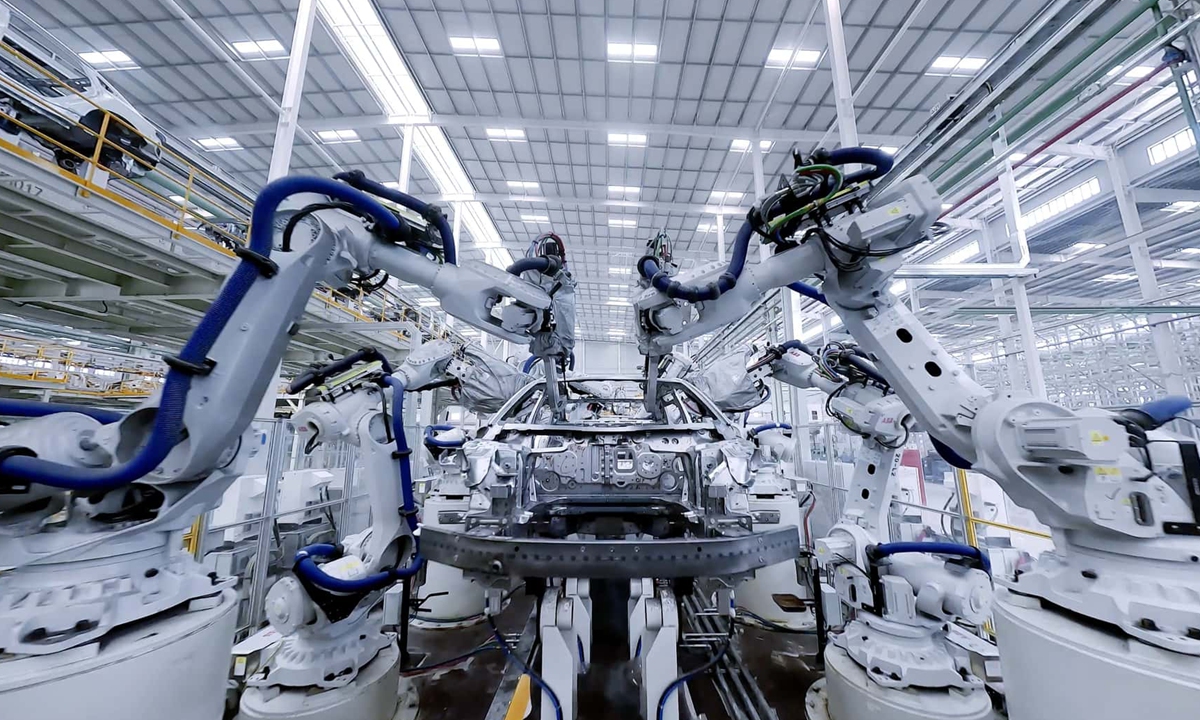
Picture shows a robotic system created by Italian company Comau, located in Grugliasco, Italy. Photo: Courtesy of Milano Finanza
The subdued hum and silent procession of electric cars, soon to be autonomous, are set to become the predominant scene on the streets of Beijing and Shanghai, rather than in Chongqing, Hangzhou, or Shenzhen, well before London, New York, or Los Angeles - if the current sales pace of battery electric vehicles (BEVs) in the Chinese market continues to grow for another two or three years, analysts predict.
The commitment with which Beijing is addressing ecological, energy, and digital transitions is yielding results, in some cases exceeding expectations. This progress is not only reflected in the statements contained in the 14th Five-Year Plan period (2021-2025), which aims to gradually increase the share of non-fossil energy consumption to around 20 percent by 2025, and the proportion of non-fossil energy power generation will reach approximately 39 percent, but also in the fact that China's renewable energy generation reached 3.46 trillion kilowatt-hours in 2024, with a year-on-year rise of 19 percent, accounting for about 35 percent of the total electricity generated, according to data released by the Chinese National Energy Administration.
Moreover, the remarkable advancements made by Chinese engineers and computer scientists in the digital economy - coinciding with the government's push for the realization of pilot projects for a super-fast 10-gigabit optical network by the end of this year - and in artificial intelligence (AI), with the New Generation Artificial Intelligence Development Plan aiming to position China as the world leader in the field by 2030, are noteworthy. This goal seems attainable, especially considering the panic that has spread among tech companies listed on Nasdaq following the emergence of Liang Wenfeng and his DeepSeek, an open-source generative AI model developed with limited resources and technology. This anxiety is largely due to the US ban on the export of next-generation Nvidia chips.
To achieve the record-speed modernization imposed by the goal of carbon neutrality by 2060, China often relies on the expertise provided by foreign companies. Italian companies have seized this opportunity for years, leveraging their know-how in sectors such as high-speed rail, agri-food, cultural heritage preservation, and green technologies in steel and chemistry, updated to meet sustainability needs. They also bring soft skills like versatility and problem-solving, which are particularly suited to a rapidly evolving market like China.
It is therefore not surprising that several Italian companies - sometimes in joint ventures with Chinese players, sometimes operating independently - are engaged in leading sectors in the Chinese market.
The automotive industry, in full transition and determined to close the gap with major Western manufacturers in terms of technologies - electric, biofuel, etc. - as well as manufacturing quality and aesthetics, has found valuable allies in companies like Comau from Grugliasco, a specialist in industrial automation and robotics, which has created an innovation center for advanced e-mobility technologies in Shanghai.
Similarly, Brembo, an Italian multinational brake manufacturer, has invested half a billion in China over the past twenty years, making it the second most important market for the Bergamo-based company, surpassed only by Germany. Pirelli has also chosen China as a testing ground for its "sensitive" tires designed for electric vehicles.
Marposs plays a key role as well, thanks to its solutions for measuring, inspecting, probing, and monitoring precision components produced in the automotive, aerospace, biomedical, and mechanical industries. Founded in Bologna in 1952 and having entered China as early as the 1970s, the company even attempted the reverse path: bringing high-end Chinese full electric automotive technology to the Emilia-Romagna region to complement the Motor Valley with a brand-new e-Valley. Although this idea did not come to fruition, the vision remains intact, and Marposs is now increasingly interested in the hydrogen frontier, for which it has already developed specific technology.
Closely linked to sustainable mobility is the energy sector, which is the stage for a delicate balancing act in China: avoiding risky jolts to growth and socioeconomic stability (Europe knows something about this). Cautious progress is being made toward gradually reducing dependence on fossil fuels. There is a focus on natural gas (whose storage is the specialty of the Italian company Snam) and, despite the still central role of coal, increasingly on renewable sources for electricity production. The Italian-French company Sediver diligently supplies glass insulators to China's State Grid - akin to Terna - and the Friulian company Danieli is leading the way in demonstrating how heavy industry can be compatible with a green approach. With its electric arc furnaces, the Buttrio-based company has captured 70 percent of the Chinese market for low-carbon steel production.
In terms of hydrogen, China is also making rapid progress: in 2024, the production targets set just two years prior were reached, and there is ample room for collaboration with Italian companies in this area. A paradigmatic example is Ufi Filters, which, in joint venture with Sinopec, is working on the industrialization of catalyzed membranes applicable to green hydrogen production.
Moreover, the progress made by Chinese researchers in the study of wave energy generators should not go unnoticed, and one can bet that the list of new technologies under study in China will further expand, given that the Asian country is best in class worldwide for the number of registered invention patents (over four million).
It is therefore appropriate to abandon the old cliché of China as the "world's factory" with low costs and technologies and to closely follow this country that is swiftly changing. China is also rapidly establishing itself as an innovation hub and influencing the rest of the world with its choices and transformations. This could happen - whether soon or later depending on geopolitical tensions - with the so-called "Polar Silk Road," or the Arctic route from Dalian to Rotterdam, which would shorten transport times between the Far East and Europe by nine days.
This would make Arctic gas pipelines, like the LNG pipeline from the Siberian Yamal Peninsula, crucial, where 28 kilometers of high-voltage cables, resistant to temperatures below -50 C and necessary for connecting the plant to the power station, have been supplied by Prysmian - another Italian company.




